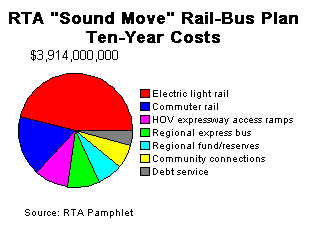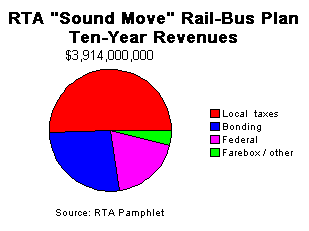
Public Interest Transportation Forum: http://www.bettertransport.info/pitf

Electric Light Rail - To be called "Link," this most expensive component of Sound Transit includes 25 miles of a "starter" system with 26 stations, designed to connect SeaTac, the Rainier Valley, downtown Seattle, First Hill, Capitol Hill and the University District. Design and preliminary engineering of the Sea-SeaTac to U-District segments will begin in the period 1998-2000 and construction will be carried out in the period 2001-2006, with service beginning as segments are completed. Also included is a 1.6 mile, 5 station, light rail segment between downtown Tacoma and a regional transportation terminal (Park & Ride) located at the Tacoma Dome. Design and construction of this separate Tacoma light rail segment will take place in the years 1998-2000, with operation beginning sometime in the period 2001-2003.
Commuter Rail - To be called "Sounder," this part of Sound Transit will provide two-way rush-hour only train service using existing railroad tracks linking Everett, Seattle and Tacoma. Seattle-Tacoma service was originally scheduled to begin at the end of 1999, but was slipped to September, 2000 as the end of 1999 approached. This 81-mile commuter rail system will be developed in partnership with private railroads, the state intercity rail program, the ports and local jurisdictions. It will provide 14 stations. Substantial improvements to the existing tracks and signal systems must be made before this service can be initiated. The tracks will be shared with freight trains and with inter-city Amtrak passenger trains. The Sounder commuter rail service has its own web page with latest schedule information.
HOV Expressway Access Ramps - direct access ramps will be paid for by the RTA Plan to let transit and carpools more easily reach and use the HOV expressway (on local segments of State and Interstate highways such as SR-520 and I-5) by eliminating the need to weave through several lanes of traffic to reach the HOV lanes. Design and construction of new ramps will be carried out throughout the years 1998-2006. At present, the regional HOV system is about half-complete and no funding for finishing this job will be provided by the RTA; it will have to come from state sources. More information about the status and expectations for completing the regional HOV system is provided.
Regional Express Bus - twenty new Regional Express bus routes will take advantage of the improved speed and reliability of the HOV expressway. This service will offer frequent, two-way service to major regional destinations throughout the day and free-up a substantial amount of existing local bus service for use in meeting other needs. Estimated cost is $361 million. Regional Express bus services will be implemented in increments, with the majority of service beginning by the end of 1999. Operations on some express routes will begin later, after facilities and community connections (see below) necessary for efficient express operation are completed. Some routes may begin with limited operations, to be increased incrementally with customer demand. The first Regional Express service is an augmentation and eventual takeover of Pierce Transit's express bus service between Lakewood/Tacoma and downtown Seattle.
Regional Fund Reserves - this $280 million will be used to fund unforeseen problems as they arise.
Community Connections - these are places where people transfer to/from cars and local buses that take travelers to their homes and neighborhoods, and where people climb aboard the RTA express bus and rail service that take them to employment and shopping centers. These Community Connections include $255 million in new and improved rail and bus stations, park & ride lots, and transit centers.
Debt Service - $171 million is the estimated cost of borrowing money through the sale of long-terms bonds by the RTA.

Local Taxes - were raised on April 1, 1997, including a 4/10th of 1 percent increase in the sales tax and a motor vehicle excise (license tab) tax increase of 3/10 of 1 percent. The amount to be raised by both new taxes over ten years is $1.98 billion. No property taxes are being used to finance the transit plan.
Bonding - long-term bonds will be used generate $1.052 billion. The term of the bonds will be up to 30-years, 20 of which are beyond the life of the 10-year (Phase I ) transit plan being proposed.
Federal funds - estimated in the original plan to be $727 million. A $500 million authorization request for Federal funds has been officially submitted to Congress by the Federal Transit Administration as of September 2000. Another $500 million will be sought later. There is a fierce national competition for these scarce "new start" funds from Washington, D.C. and there is little likelihood that this situation will change much in the next few years.
Fare box and Other Revenues - estimated to be $155 million or about 4% of the total revenues.
Prepared by the Editors, Public Interest Transportation Forum
Source of information: Launching a Rapid Transit System in the Puget Sound Region,
undated, 4 pages, Produced by the Regional Transit Authority, 821 Second Avenue, M.S. 151,
Seattle, WA. 98104-1598. Also, the Sound Move draft Implementation Guide, and the
On Board RTA Meeting Report of March 27 and October 9, 1997. Link to official RTA documents.
Direct access to the Official RTA Sound Move Implementation Guide released in late March 1997.
Return to the Public Interest Transportation Forum home page.
Last modified: February 07, 2011